A Comparative Study of Coal Fired Power Plant Standards Globally
VerifiedAdded on 2020/10/15
|17
|5231
|558
Report
AI Summary
This report, prepared by Muhammad Tayyab, a student at the University of Engineering and Technology Lahore, provides a comprehensive analysis of coal-fired power plants. It begins with an abstract highlighting the significance of coal in Pakistan's energy sector, referencing global, national, and provisional standards of coal-fired power plants, including US, EU, and Japanese standards, and national recommendations. The report then delves into various clean coal technologies, categorizing them into coal processing, high-efficiency combustion, coal transformation, and post-combustion pollution treatment technologies. It further discusses the suitability of these technologies for Pakistan's coal reserves, focusing on coal gasification. The report also examines techniques to utilize local coal, addressing issues in mining, transportation, and utilization, alongside the environmental impact, cost comparison, and the social and economic benefits of local coal. The report concludes with an overview of the environmental impact and sustainability of local coal use, offering a comprehensive evaluation of the subject matter.
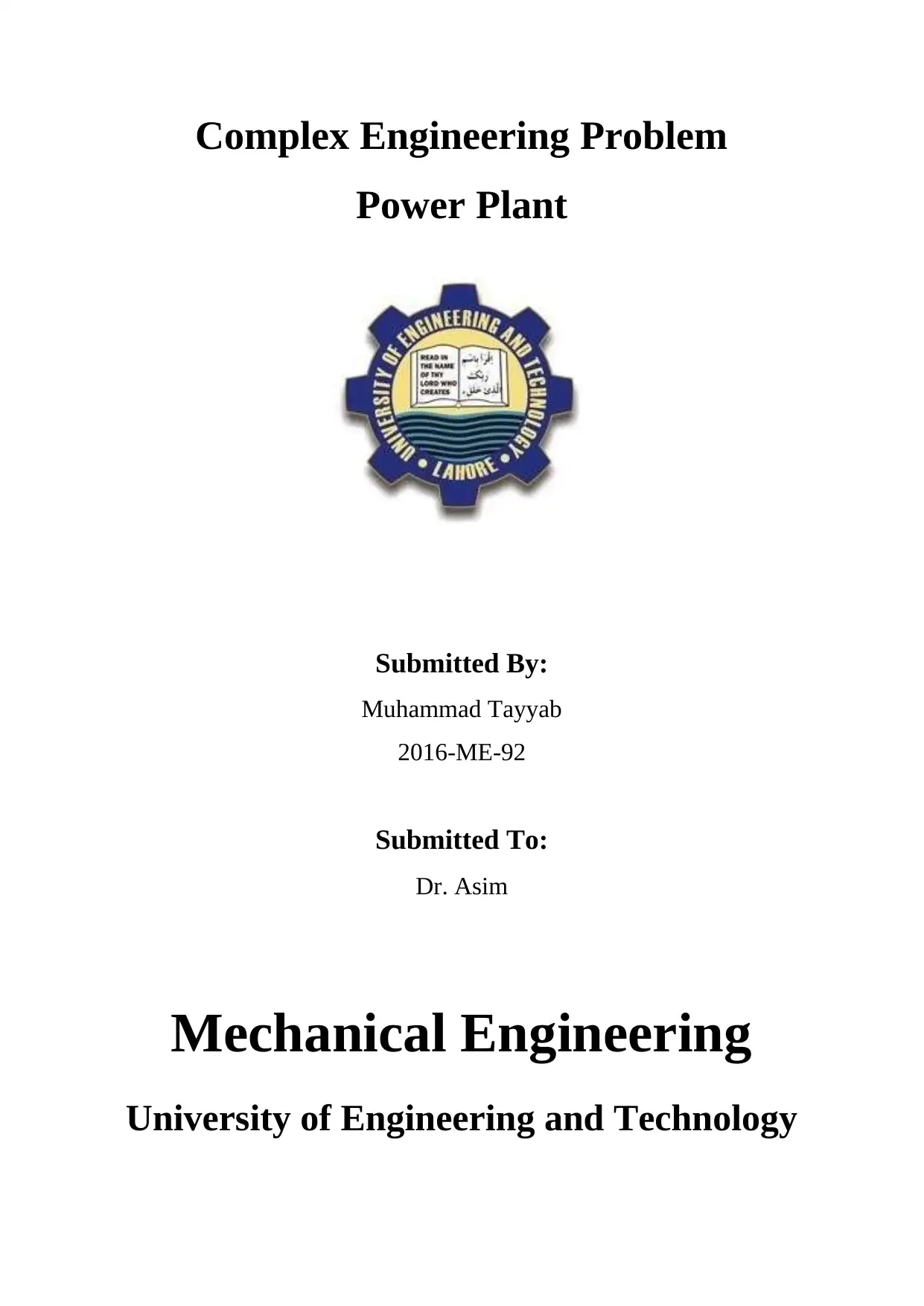
Complex Engineering Problem
Power Plant
Submitted By:
Muhammad Tayyab
2016-ME-92
Submitted To:
Dr. Asim
Mechanical Engineering
University of Engineering and Technology
Power Plant
Submitted By:
Muhammad Tayyab
2016-ME-92
Submitted To:
Dr. Asim
Mechanical Engineering
University of Engineering and Technology
Paraphrase This Document
Need a fresh take? Get an instant paraphrase of this document with our AI Paraphraser
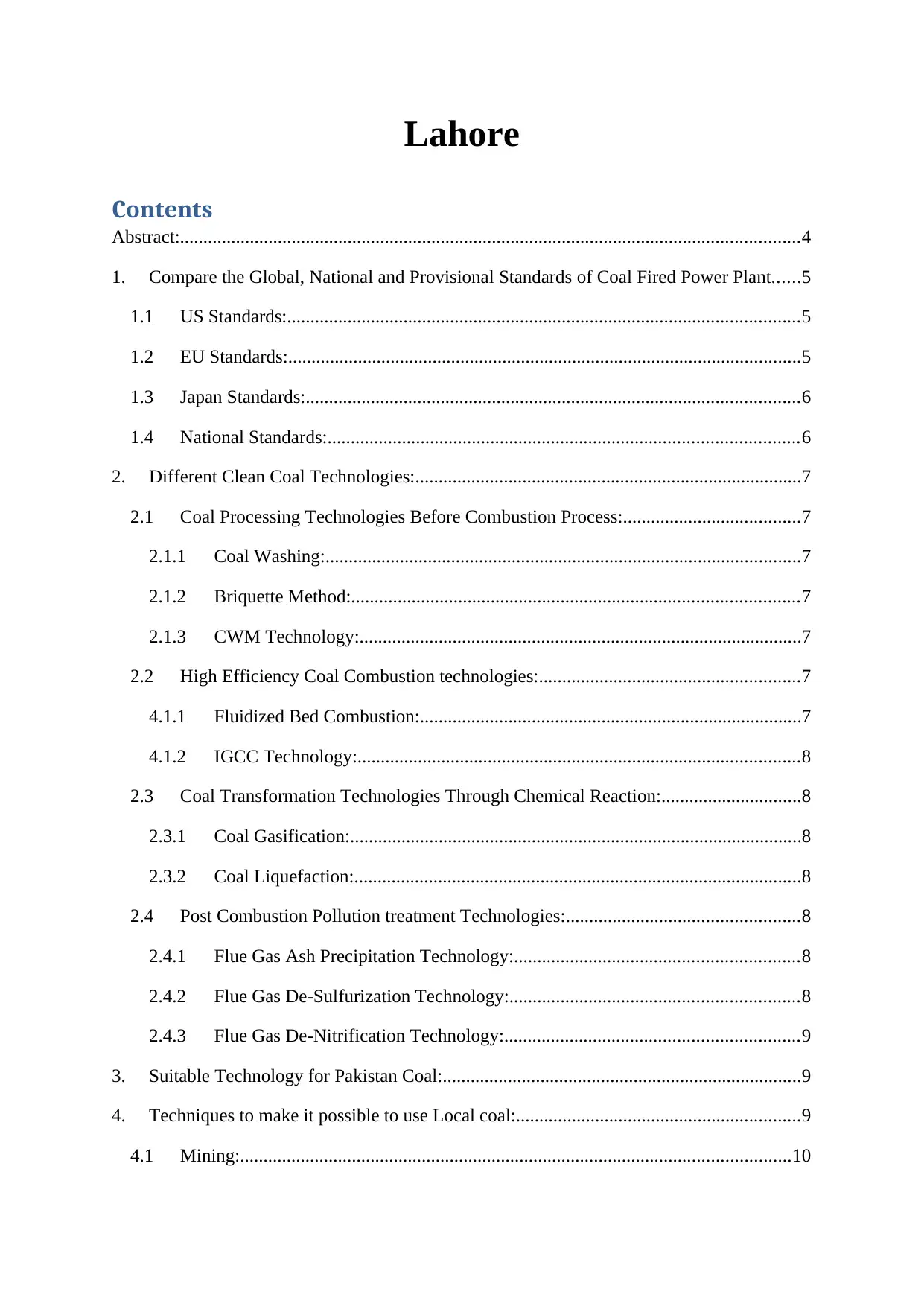
Lahore
Contents
Abstract:.....................................................................................................................................4
1. Compare the Global, National and Provisional Standards of Coal Fired Power Plant......5
1.1 US Standards:..............................................................................................................5
1.2 EU Standards:..............................................................................................................5
1.3 Japan Standards:..........................................................................................................6
1.4 National Standards:.....................................................................................................6
2. Different Clean Coal Technologies:...................................................................................7
2.1 Coal Processing Technologies Before Combustion Process:......................................7
2.1.1 Coal Washing:......................................................................................................7
2.1.2 Briquette Method:................................................................................................7
2.1.3 CWM Technology:...............................................................................................7
2.2 High Efficiency Coal Combustion technologies:........................................................7
4.1.1 Fluidized Bed Combustion:..................................................................................7
4.1.2 IGCC Technology:...............................................................................................8
2.3 Coal Transformation Technologies Through Chemical Reaction:..............................8
2.3.1 Coal Gasification:.................................................................................................8
2.3.2 Coal Liquefaction:................................................................................................8
2.4 Post Combustion Pollution treatment Technologies:..................................................8
2.4.1 Flue Gas Ash Precipitation Technology:.............................................................8
2.4.2 Flue Gas De-Sulfurization Technology:..............................................................8
2.4.3 Flue Gas De-Nitrification Technology:...............................................................9
3. Suitable Technology for Pakistan Coal:.............................................................................9
4. Techniques to make it possible to use Local coal:.............................................................9
4.1 Mining:......................................................................................................................10
Contents
Abstract:.....................................................................................................................................4
1. Compare the Global, National and Provisional Standards of Coal Fired Power Plant......5
1.1 US Standards:..............................................................................................................5
1.2 EU Standards:..............................................................................................................5
1.3 Japan Standards:..........................................................................................................6
1.4 National Standards:.....................................................................................................6
2. Different Clean Coal Technologies:...................................................................................7
2.1 Coal Processing Technologies Before Combustion Process:......................................7
2.1.1 Coal Washing:......................................................................................................7
2.1.2 Briquette Method:................................................................................................7
2.1.3 CWM Technology:...............................................................................................7
2.2 High Efficiency Coal Combustion technologies:........................................................7
4.1.1 Fluidized Bed Combustion:..................................................................................7
4.1.2 IGCC Technology:...............................................................................................8
2.3 Coal Transformation Technologies Through Chemical Reaction:..............................8
2.3.1 Coal Gasification:.................................................................................................8
2.3.2 Coal Liquefaction:................................................................................................8
2.4 Post Combustion Pollution treatment Technologies:..................................................8
2.4.1 Flue Gas Ash Precipitation Technology:.............................................................8
2.4.2 Flue Gas De-Sulfurization Technology:..............................................................8
2.4.3 Flue Gas De-Nitrification Technology:...............................................................9
3. Suitable Technology for Pakistan Coal:.............................................................................9
4. Techniques to make it possible to use Local coal:.............................................................9
4.1 Mining:......................................................................................................................10
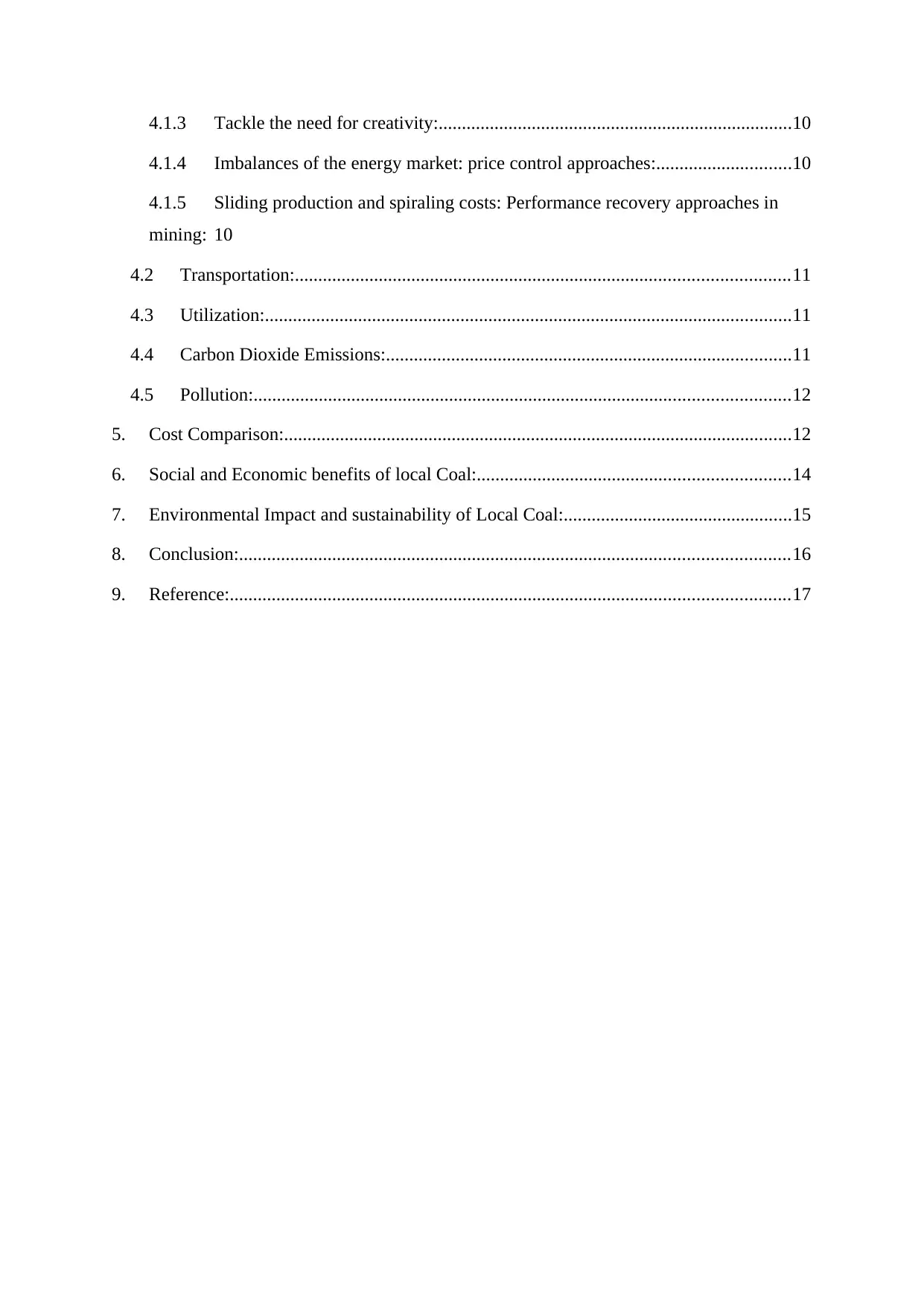
4.1.3 Tackle the need for creativity:............................................................................10
4.1.4 Imbalances of the energy market: price control approaches:.............................10
4.1.5 Sliding production and spiraling costs: Performance recovery approaches in
mining: 10
4.2 Transportation:..........................................................................................................11
4.3 Utilization:.................................................................................................................11
4.4 Carbon Dioxide Emissions:.......................................................................................11
4.5 Pollution:...................................................................................................................12
5. Cost Comparison:.............................................................................................................12
6. Social and Economic benefits of local Coal:...................................................................14
7. Environmental Impact and sustainability of Local Coal:.................................................15
8. Conclusion:......................................................................................................................16
9. Reference:........................................................................................................................17
4.1.4 Imbalances of the energy market: price control approaches:.............................10
4.1.5 Sliding production and spiraling costs: Performance recovery approaches in
mining: 10
4.2 Transportation:..........................................................................................................11
4.3 Utilization:.................................................................................................................11
4.4 Carbon Dioxide Emissions:.......................................................................................11
4.5 Pollution:...................................................................................................................12
5. Cost Comparison:.............................................................................................................12
6. Social and Economic benefits of local Coal:...................................................................14
7. Environmental Impact and sustainability of Local Coal:.................................................15
8. Conclusion:......................................................................................................................16
9. Reference:........................................................................................................................17
⊘ This is a preview!⊘
Do you want full access?
Subscribe today to unlock all pages.

Trusted by 1+ million students worldwide
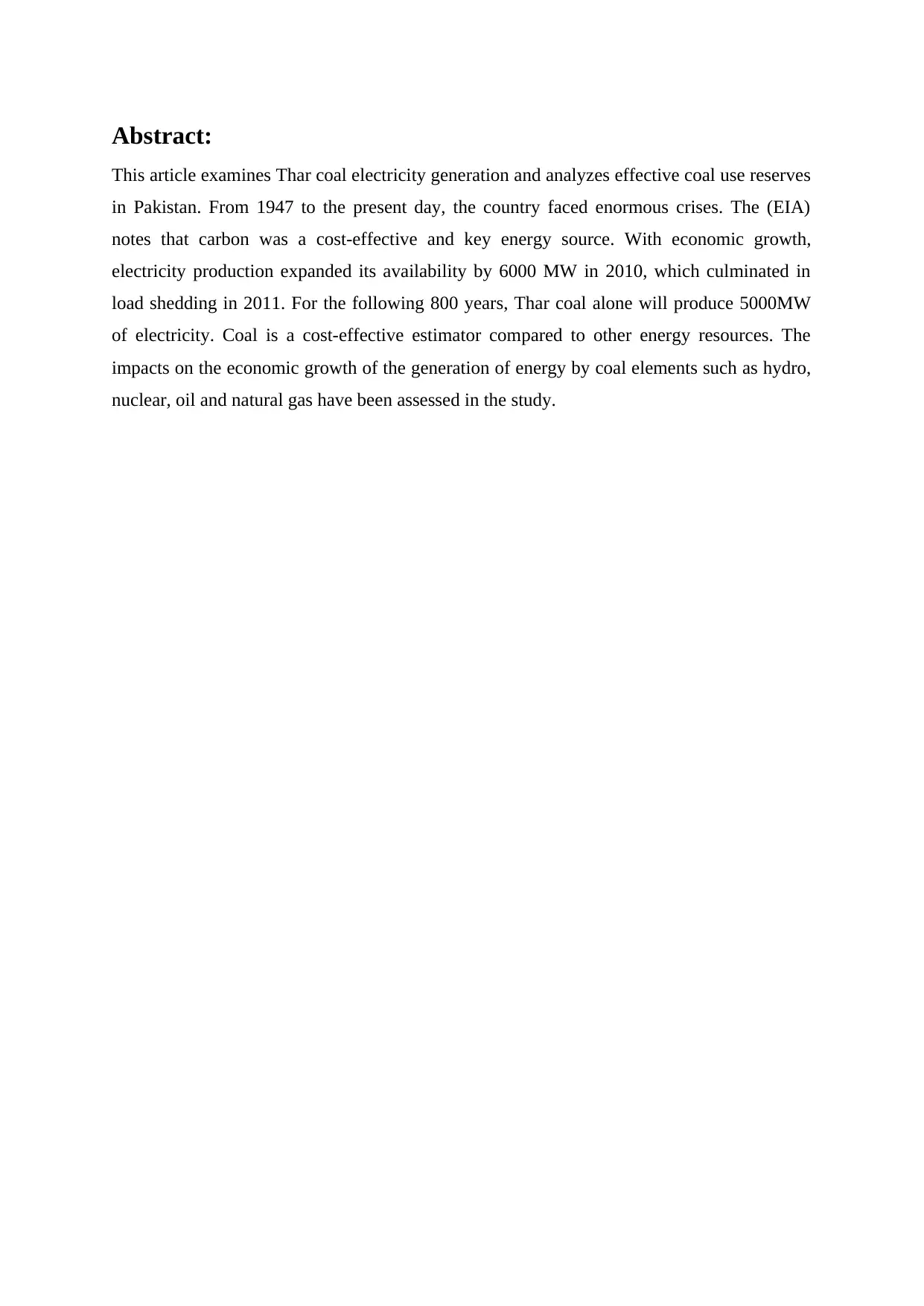
Abstract:
This article examines Thar coal electricity generation and analyzes effective coal use reserves
in Pakistan. From 1947 to the present day, the country faced enormous crises. The (EIA)
notes that carbon was a cost-effective and key energy source. With economic growth,
electricity production expanded its availability by 6000 MW in 2010, which culminated in
load shedding in 2011. For the following 800 years, Thar coal alone will produce 5000MW
of electricity. Coal is a cost-effective estimator compared to other energy resources. The
impacts on the economic growth of the generation of energy by coal elements such as hydro,
nuclear, oil and natural gas have been assessed in the study.
This article examines Thar coal electricity generation and analyzes effective coal use reserves
in Pakistan. From 1947 to the present day, the country faced enormous crises. The (EIA)
notes that carbon was a cost-effective and key energy source. With economic growth,
electricity production expanded its availability by 6000 MW in 2010, which culminated in
load shedding in 2011. For the following 800 years, Thar coal alone will produce 5000MW
of electricity. Coal is a cost-effective estimator compared to other energy resources. The
impacts on the economic growth of the generation of energy by coal elements such as hydro,
nuclear, oil and natural gas have been assessed in the study.
Paraphrase This Document
Need a fresh take? Get an instant paraphrase of this document with our AI Paraphraser
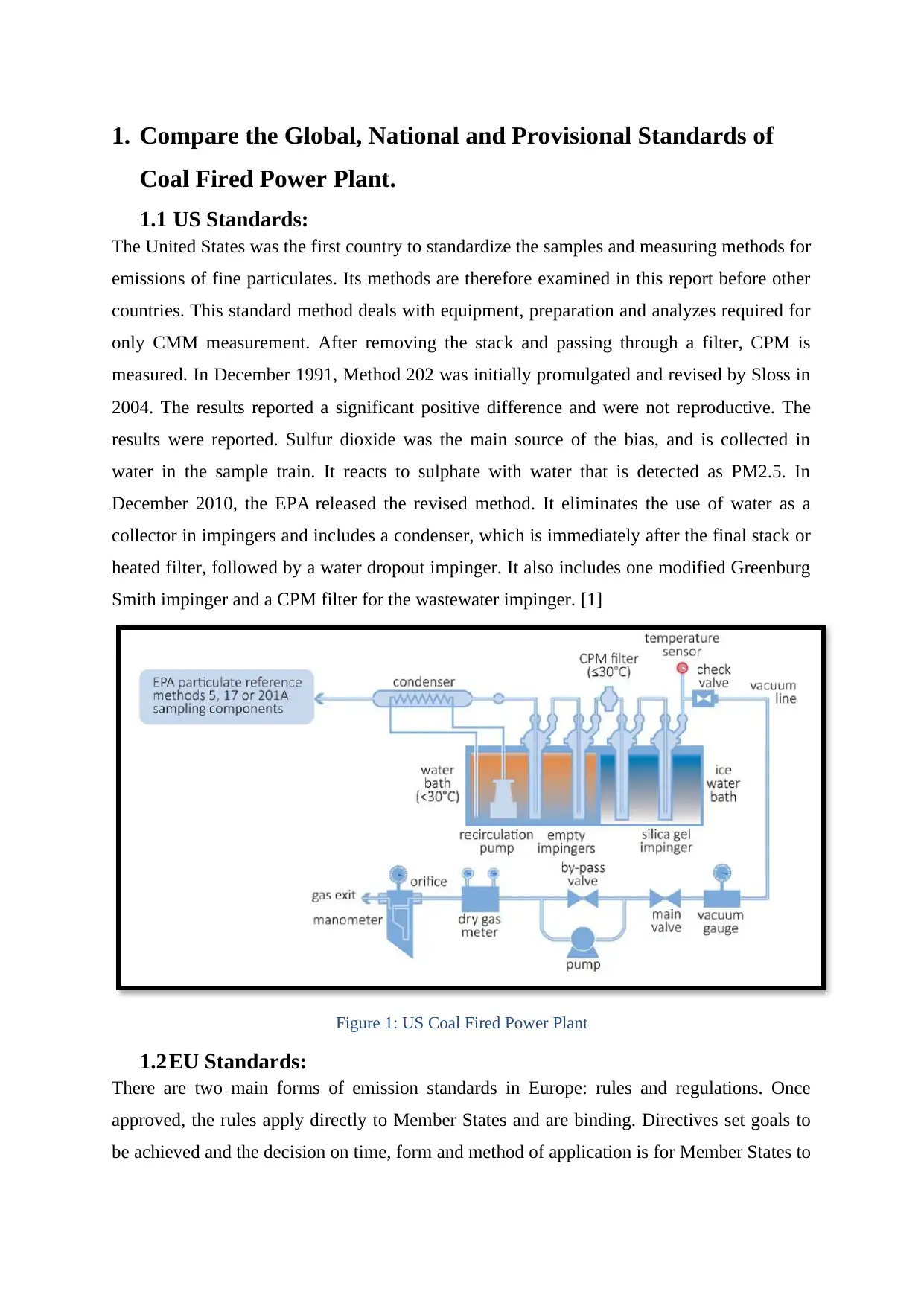
1. Compare the Global, National and Provisional Standards of
Coal Fired Power Plant.
1.1 US Standards:
The United States was the first country to standardize the samples and measuring methods for
emissions of fine particulates. Its methods are therefore examined in this report before other
countries. This standard method deals with equipment, preparation and analyzes required for
only CMM measurement. After removing the stack and passing through a filter, CPM is
measured. In December 1991, Method 202 was initially promulgated and revised by Sloss in
2004. The results reported a significant positive difference and were not reproductive. The
results were reported. Sulfur dioxide was the main source of the bias, and is collected in
water in the sample train. It reacts to sulphate with water that is detected as PM2.5. In
December 2010, the EPA released the revised method. It eliminates the use of water as a
collector in impingers and includes a condenser, which is immediately after the final stack or
heated filter, followed by a water dropout impinger. It also includes one modified Greenburg
Smith impinger and a CPM filter for the wastewater impinger. [1]
Figure 1: US Coal Fired Power Plant
1.2EU Standards:
There are two main forms of emission standards in Europe: rules and regulations. Once
approved, the rules apply directly to Member States and are binding. Directives set goals to
be achieved and the decision on time, form and method of application is for Member States to
Coal Fired Power Plant.
1.1 US Standards:
The United States was the first country to standardize the samples and measuring methods for
emissions of fine particulates. Its methods are therefore examined in this report before other
countries. This standard method deals with equipment, preparation and analyzes required for
only CMM measurement. After removing the stack and passing through a filter, CPM is
measured. In December 1991, Method 202 was initially promulgated and revised by Sloss in
2004. The results reported a significant positive difference and were not reproductive. The
results were reported. Sulfur dioxide was the main source of the bias, and is collected in
water in the sample train. It reacts to sulphate with water that is detected as PM2.5. In
December 2010, the EPA released the revised method. It eliminates the use of water as a
collector in impingers and includes a condenser, which is immediately after the final stack or
heated filter, followed by a water dropout impinger. It also includes one modified Greenburg
Smith impinger and a CPM filter for the wastewater impinger. [1]
Figure 1: US Coal Fired Power Plant
1.2EU Standards:
There are two main forms of emission standards in Europe: rules and regulations. Once
approved, the rules apply directly to Member States and are binding. Directives set goals to
be achieved and the decision on time, form and method of application is for Member States to
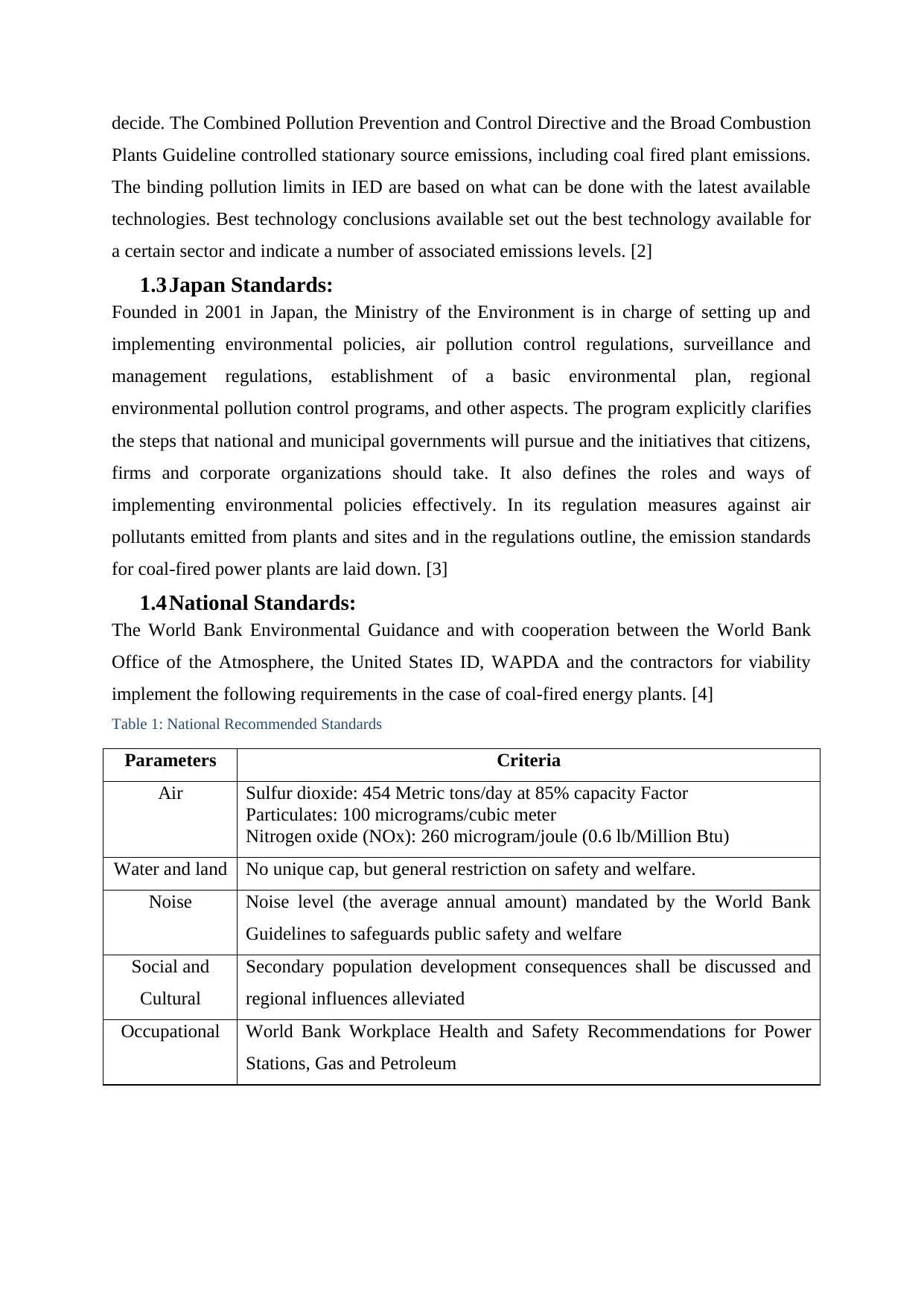
decide. The Combined Pollution Prevention and Control Directive and the Broad Combustion
Plants Guideline controlled stationary source emissions, including coal fired plant emissions.
The binding pollution limits in IED are based on what can be done with the latest available
technologies. Best technology conclusions available set out the best technology available for
a certain sector and indicate a number of associated emissions levels. [2]
1.3Japan Standards:
Founded in 2001 in Japan, the Ministry of the Environment is in charge of setting up and
implementing environmental policies, air pollution control regulations, surveillance and
management regulations, establishment of a basic environmental plan, regional
environmental pollution control programs, and other aspects. The program explicitly clarifies
the steps that national and municipal governments will pursue and the initiatives that citizens,
firms and corporate organizations should take. It also defines the roles and ways of
implementing environmental policies effectively. In its regulation measures against air
pollutants emitted from plants and sites and in the regulations outline, the emission standards
for coal-fired power plants are laid down. [3]
1.4National Standards:
The World Bank Environmental Guidance and with cooperation between the World Bank
Office of the Atmosphere, the United States ID, WAPDA and the contractors for viability
implement the following requirements in the case of coal-fired energy plants. [4]
Table 1: National Recommended Standards
Parameters Criteria
Air Sulfur dioxide: 454 Metric tons/day at 85% capacity Factor
Particulates: 100 micrograms/cubic meter
Nitrogen oxide (NOx): 260 microgram/joule (0.6 lb/Million Btu)
Water and land No unique cap, but general restriction on safety and welfare.
Noise Noise level (the average annual amount) mandated by the World Bank
Guidelines to safeguards public safety and welfare
Social and
Cultural
Secondary population development consequences shall be discussed and
regional influences alleviated
Occupational World Bank Workplace Health and Safety Recommendations for Power
Stations, Gas and Petroleum
Plants Guideline controlled stationary source emissions, including coal fired plant emissions.
The binding pollution limits in IED are based on what can be done with the latest available
technologies. Best technology conclusions available set out the best technology available for
a certain sector and indicate a number of associated emissions levels. [2]
1.3Japan Standards:
Founded in 2001 in Japan, the Ministry of the Environment is in charge of setting up and
implementing environmental policies, air pollution control regulations, surveillance and
management regulations, establishment of a basic environmental plan, regional
environmental pollution control programs, and other aspects. The program explicitly clarifies
the steps that national and municipal governments will pursue and the initiatives that citizens,
firms and corporate organizations should take. It also defines the roles and ways of
implementing environmental policies effectively. In its regulation measures against air
pollutants emitted from plants and sites and in the regulations outline, the emission standards
for coal-fired power plants are laid down. [3]
1.4National Standards:
The World Bank Environmental Guidance and with cooperation between the World Bank
Office of the Atmosphere, the United States ID, WAPDA and the contractors for viability
implement the following requirements in the case of coal-fired energy plants. [4]
Table 1: National Recommended Standards
Parameters Criteria
Air Sulfur dioxide: 454 Metric tons/day at 85% capacity Factor
Particulates: 100 micrograms/cubic meter
Nitrogen oxide (NOx): 260 microgram/joule (0.6 lb/Million Btu)
Water and land No unique cap, but general restriction on safety and welfare.
Noise Noise level (the average annual amount) mandated by the World Bank
Guidelines to safeguards public safety and welfare
Social and
Cultural
Secondary population development consequences shall be discussed and
regional influences alleviated
Occupational World Bank Workplace Health and Safety Recommendations for Power
Stations, Gas and Petroleum
⊘ This is a preview!⊘
Do you want full access?
Subscribe today to unlock all pages.

Trusted by 1+ million students worldwide
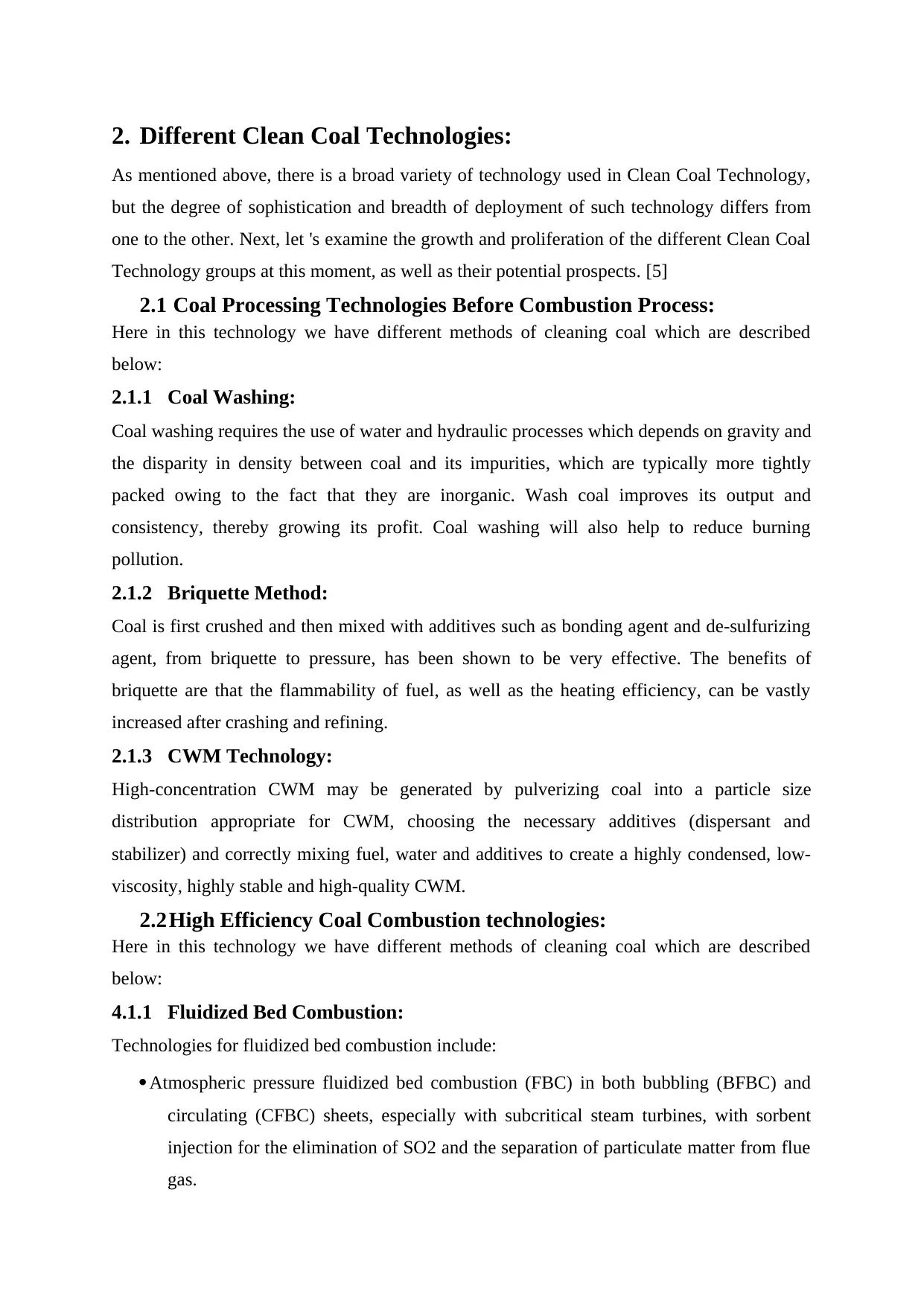
2. Different Clean Coal Technologies:
As mentioned above, there is a broad variety of technology used in Clean Coal Technology,
but the degree of sophistication and breadth of deployment of such technology differs from
one to the other. Next, let 's examine the growth and proliferation of the different Clean Coal
Technology groups at this moment, as well as their potential prospects. [5]
2.1 Coal Processing Technologies Before Combustion Process:
Here in this technology we have different methods of cleaning coal which are described
below:
2.1.1 Coal Washing:
Coal washing requires the use of water and hydraulic processes which depends on gravity and
the disparity in density between coal and its impurities, which are typically more tightly
packed owing to the fact that they are inorganic. Wash coal improves its output and
consistency, thereby growing its profit. Coal washing will also help to reduce burning
pollution.
2.1.2 Briquette Method:
Coal is first crushed and then mixed with additives such as bonding agent and de-sulfurizing
agent, from briquette to pressure, has been shown to be very effective. The benefits of
briquette are that the flammability of fuel, as well as the heating efficiency, can be vastly
increased after crashing and refining.
2.1.3 CWM Technology:
High-concentration CWM may be generated by pulverizing coal into a particle size
distribution appropriate for CWM, choosing the necessary additives (dispersant and
stabilizer) and correctly mixing fuel, water and additives to create a highly condensed, low-
viscosity, highly stable and high-quality CWM.
2.2High Efficiency Coal Combustion technologies:
Here in this technology we have different methods of cleaning coal which are described
below:
4.1.1 Fluidized Bed Combustion:
Technologies for fluidized bed combustion include:
Atmospheric pressure fluidized bed combustion (FBC) in both bubbling (BFBC) and
circulating (CFBC) sheets, especially with subcritical steam turbines, with sorbent
injection for the elimination of SO2 and the separation of particulate matter from flue
gas.
As mentioned above, there is a broad variety of technology used in Clean Coal Technology,
but the degree of sophistication and breadth of deployment of such technology differs from
one to the other. Next, let 's examine the growth and proliferation of the different Clean Coal
Technology groups at this moment, as well as their potential prospects. [5]
2.1 Coal Processing Technologies Before Combustion Process:
Here in this technology we have different methods of cleaning coal which are described
below:
2.1.1 Coal Washing:
Coal washing requires the use of water and hydraulic processes which depends on gravity and
the disparity in density between coal and its impurities, which are typically more tightly
packed owing to the fact that they are inorganic. Wash coal improves its output and
consistency, thereby growing its profit. Coal washing will also help to reduce burning
pollution.
2.1.2 Briquette Method:
Coal is first crushed and then mixed with additives such as bonding agent and de-sulfurizing
agent, from briquette to pressure, has been shown to be very effective. The benefits of
briquette are that the flammability of fuel, as well as the heating efficiency, can be vastly
increased after crashing and refining.
2.1.3 CWM Technology:
High-concentration CWM may be generated by pulverizing coal into a particle size
distribution appropriate for CWM, choosing the necessary additives (dispersant and
stabilizer) and correctly mixing fuel, water and additives to create a highly condensed, low-
viscosity, highly stable and high-quality CWM.
2.2High Efficiency Coal Combustion technologies:
Here in this technology we have different methods of cleaning coal which are described
below:
4.1.1 Fluidized Bed Combustion:
Technologies for fluidized bed combustion include:
Atmospheric pressure fluidized bed combustion (FBC) in both bubbling (BFBC) and
circulating (CFBC) sheets, especially with subcritical steam turbines, with sorbent
injection for the elimination of SO2 and the separation of particulate matter from flue
gas.
Paraphrase This Document
Need a fresh take? Get an instant paraphrase of this document with our AI Paraphraser
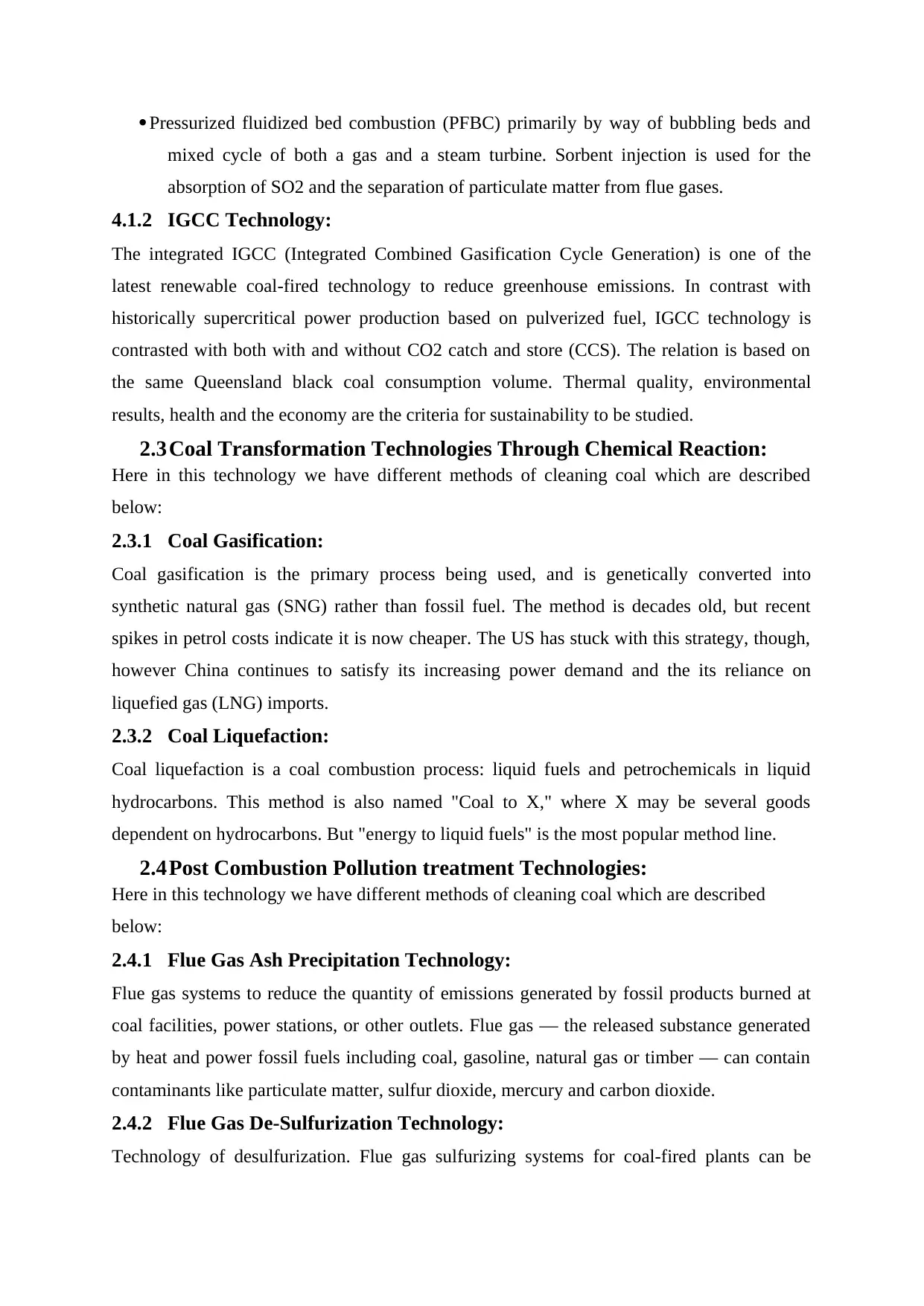
Pressurized fluidized bed combustion (PFBC) primarily by way of bubbling beds and
mixed cycle of both a gas and a steam turbine. Sorbent injection is used for the
absorption of SO2 and the separation of particulate matter from flue gases.
4.1.2 IGCC Technology:
The integrated IGCC (Integrated Combined Gasification Cycle Generation) is one of the
latest renewable coal-fired technology to reduce greenhouse emissions. In contrast with
historically supercritical power production based on pulverized fuel, IGCC technology is
contrasted with both with and without CO2 catch and store (CCS). The relation is based on
the same Queensland black coal consumption volume. Thermal quality, environmental
results, health and the economy are the criteria for sustainability to be studied.
2.3Coal Transformation Technologies Through Chemical Reaction:
Here in this technology we have different methods of cleaning coal which are described
below:
2.3.1 Coal Gasification:
Coal gasification is the primary process being used, and is genetically converted into
synthetic natural gas (SNG) rather than fossil fuel. The method is decades old, but recent
spikes in petrol costs indicate it is now cheaper. The US has stuck with this strategy, though,
however China continues to satisfy its increasing power demand and the its reliance on
liquefied gas (LNG) imports.
2.3.2 Coal Liquefaction:
Coal liquefaction is a coal combustion process: liquid fuels and petrochemicals in liquid
hydrocarbons. This method is also named "Coal to X," where X may be several goods
dependent on hydrocarbons. But "energy to liquid fuels" is the most popular method line.
2.4Post Combustion Pollution treatment Technologies:
Here in this technology we have different methods of cleaning coal which are described
below:
2.4.1 Flue Gas Ash Precipitation Technology:
Flue gas systems to reduce the quantity of emissions generated by fossil products burned at
coal facilities, power stations, or other outlets. Flue gas — the released substance generated
by heat and power fossil fuels including coal, gasoline, natural gas or timber — can contain
contaminants like particulate matter, sulfur dioxide, mercury and carbon dioxide.
2.4.2 Flue Gas De-Sulfurization Technology:
Technology of desulfurization. Flue gas sulfurizing systems for coal-fired plants can be
mixed cycle of both a gas and a steam turbine. Sorbent injection is used for the
absorption of SO2 and the separation of particulate matter from flue gases.
4.1.2 IGCC Technology:
The integrated IGCC (Integrated Combined Gasification Cycle Generation) is one of the
latest renewable coal-fired technology to reduce greenhouse emissions. In contrast with
historically supercritical power production based on pulverized fuel, IGCC technology is
contrasted with both with and without CO2 catch and store (CCS). The relation is based on
the same Queensland black coal consumption volume. Thermal quality, environmental
results, health and the economy are the criteria for sustainability to be studied.
2.3Coal Transformation Technologies Through Chemical Reaction:
Here in this technology we have different methods of cleaning coal which are described
below:
2.3.1 Coal Gasification:
Coal gasification is the primary process being used, and is genetically converted into
synthetic natural gas (SNG) rather than fossil fuel. The method is decades old, but recent
spikes in petrol costs indicate it is now cheaper. The US has stuck with this strategy, though,
however China continues to satisfy its increasing power demand and the its reliance on
liquefied gas (LNG) imports.
2.3.2 Coal Liquefaction:
Coal liquefaction is a coal combustion process: liquid fuels and petrochemicals in liquid
hydrocarbons. This method is also named "Coal to X," where X may be several goods
dependent on hydrocarbons. But "energy to liquid fuels" is the most popular method line.
2.4Post Combustion Pollution treatment Technologies:
Here in this technology we have different methods of cleaning coal which are described
below:
2.4.1 Flue Gas Ash Precipitation Technology:
Flue gas systems to reduce the quantity of emissions generated by fossil products burned at
coal facilities, power stations, or other outlets. Flue gas — the released substance generated
by heat and power fossil fuels including coal, gasoline, natural gas or timber — can contain
contaminants like particulate matter, sulfur dioxide, mercury and carbon dioxide.
2.4.2 Flue Gas De-Sulfurization Technology:
Technology of desulfurization. Flue gas sulfurizing systems for coal-fired plants can be
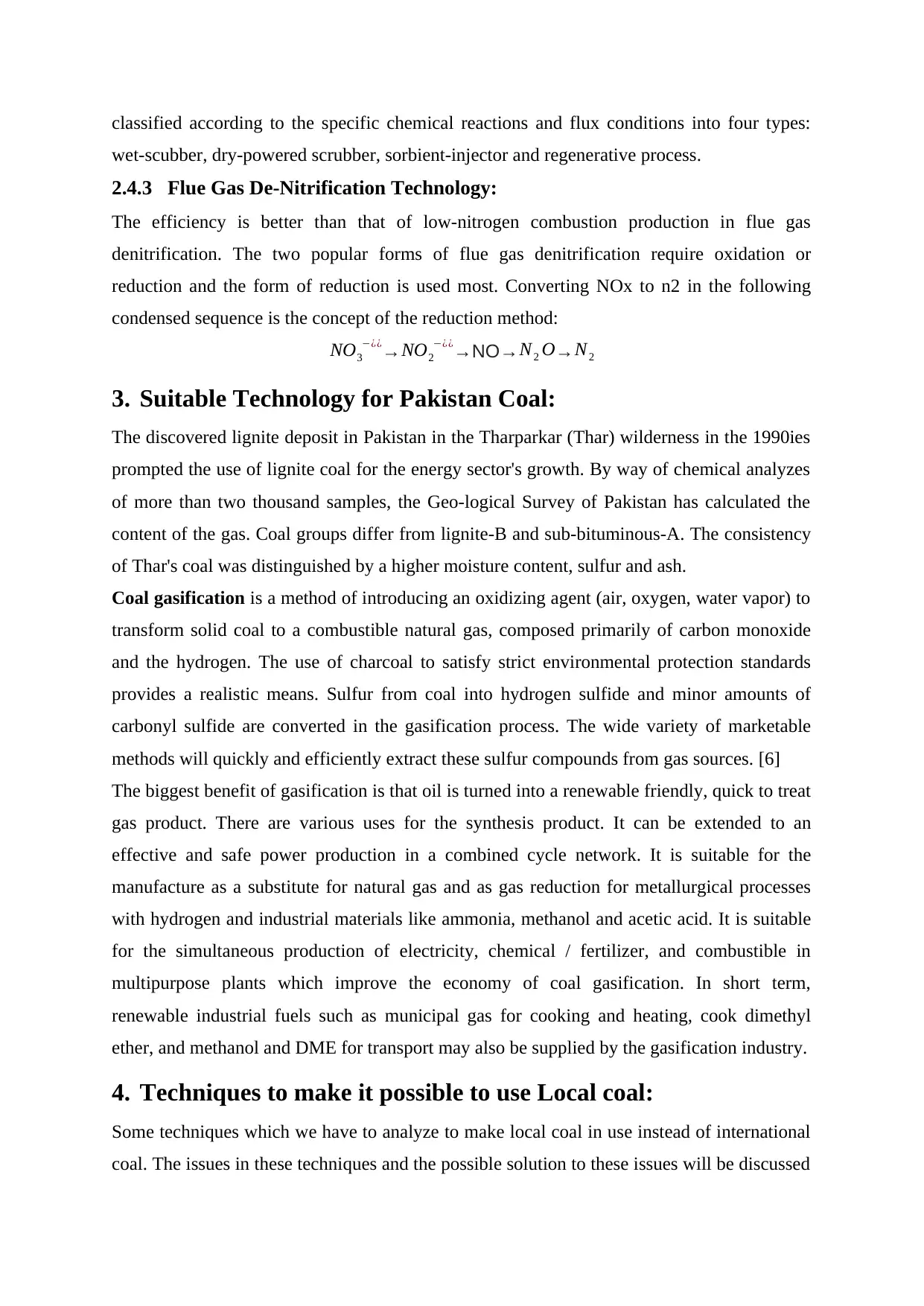
classified according to the specific chemical reactions and flux conditions into four types:
wet-scubber, dry-powered scrubber, sorbient-injector and regenerative process.
2.4.3 Flue Gas De-Nitrification Technology:
The efficiency is better than that of low-nitrogen combustion production in flue gas
denitrification. The two popular forms of flue gas denitrification require oxidation or
reduction and the form of reduction is used most. Converting NOx to n2 in the following
condensed sequence is the concept of the reduction method:
NO3
−¿¿→NO2
−¿¿→NO→ N2 O→ N2
3. Suitable Technology for Pakistan Coal:
The discovered lignite deposit in Pakistan in the Tharparkar (Thar) wilderness in the 1990ies
prompted the use of lignite coal for the energy sector's growth. By way of chemical analyzes
of more than two thousand samples, the Geo-logical Survey of Pakistan has calculated the
content of the gas. Coal groups differ from lignite-B and sub-bituminous-A. The consistency
of Thar's coal was distinguished by a higher moisture content, sulfur and ash.
Coal gasification is a method of introducing an oxidizing agent (air, oxygen, water vapor) to
transform solid coal to a combustible natural gas, composed primarily of carbon monoxide
and the hydrogen. The use of charcoal to satisfy strict environmental protection standards
provides a realistic means. Sulfur from coal into hydrogen sulfide and minor amounts of
carbonyl sulfide are converted in the gasification process. The wide variety of marketable
methods will quickly and efficiently extract these sulfur compounds from gas sources. [6]
The biggest benefit of gasification is that oil is turned into a renewable friendly, quick to treat
gas product. There are various uses for the synthesis product. It can be extended to an
effective and safe power production in a combined cycle network. It is suitable for the
manufacture as a substitute for natural gas and as gas reduction for metallurgical processes
with hydrogen and industrial materials like ammonia, methanol and acetic acid. It is suitable
for the simultaneous production of electricity, chemical / fertilizer, and combustible in
multipurpose plants which improve the economy of coal gasification. In short term,
renewable industrial fuels such as municipal gas for cooking and heating, cook dimethyl
ether, and methanol and DME for transport may also be supplied by the gasification industry.
4. Techniques to make it possible to use Local coal:
Some techniques which we have to analyze to make local coal in use instead of international
coal. The issues in these techniques and the possible solution to these issues will be discussed
wet-scubber, dry-powered scrubber, sorbient-injector and regenerative process.
2.4.3 Flue Gas De-Nitrification Technology:
The efficiency is better than that of low-nitrogen combustion production in flue gas
denitrification. The two popular forms of flue gas denitrification require oxidation or
reduction and the form of reduction is used most. Converting NOx to n2 in the following
condensed sequence is the concept of the reduction method:
NO3
−¿¿→NO2
−¿¿→NO→ N2 O→ N2
3. Suitable Technology for Pakistan Coal:
The discovered lignite deposit in Pakistan in the Tharparkar (Thar) wilderness in the 1990ies
prompted the use of lignite coal for the energy sector's growth. By way of chemical analyzes
of more than two thousand samples, the Geo-logical Survey of Pakistan has calculated the
content of the gas. Coal groups differ from lignite-B and sub-bituminous-A. The consistency
of Thar's coal was distinguished by a higher moisture content, sulfur and ash.
Coal gasification is a method of introducing an oxidizing agent (air, oxygen, water vapor) to
transform solid coal to a combustible natural gas, composed primarily of carbon monoxide
and the hydrogen. The use of charcoal to satisfy strict environmental protection standards
provides a realistic means. Sulfur from coal into hydrogen sulfide and minor amounts of
carbonyl sulfide are converted in the gasification process. The wide variety of marketable
methods will quickly and efficiently extract these sulfur compounds from gas sources. [6]
The biggest benefit of gasification is that oil is turned into a renewable friendly, quick to treat
gas product. There are various uses for the synthesis product. It can be extended to an
effective and safe power production in a combined cycle network. It is suitable for the
manufacture as a substitute for natural gas and as gas reduction for metallurgical processes
with hydrogen and industrial materials like ammonia, methanol and acetic acid. It is suitable
for the simultaneous production of electricity, chemical / fertilizer, and combustible in
multipurpose plants which improve the economy of coal gasification. In short term,
renewable industrial fuels such as municipal gas for cooking and heating, cook dimethyl
ether, and methanol and DME for transport may also be supplied by the gasification industry.
4. Techniques to make it possible to use Local coal:
Some techniques which we have to analyze to make local coal in use instead of international
coal. The issues in these techniques and the possible solution to these issues will be discussed
⊘ This is a preview!⊘
Do you want full access?
Subscribe today to unlock all pages.

Trusted by 1+ million students worldwide
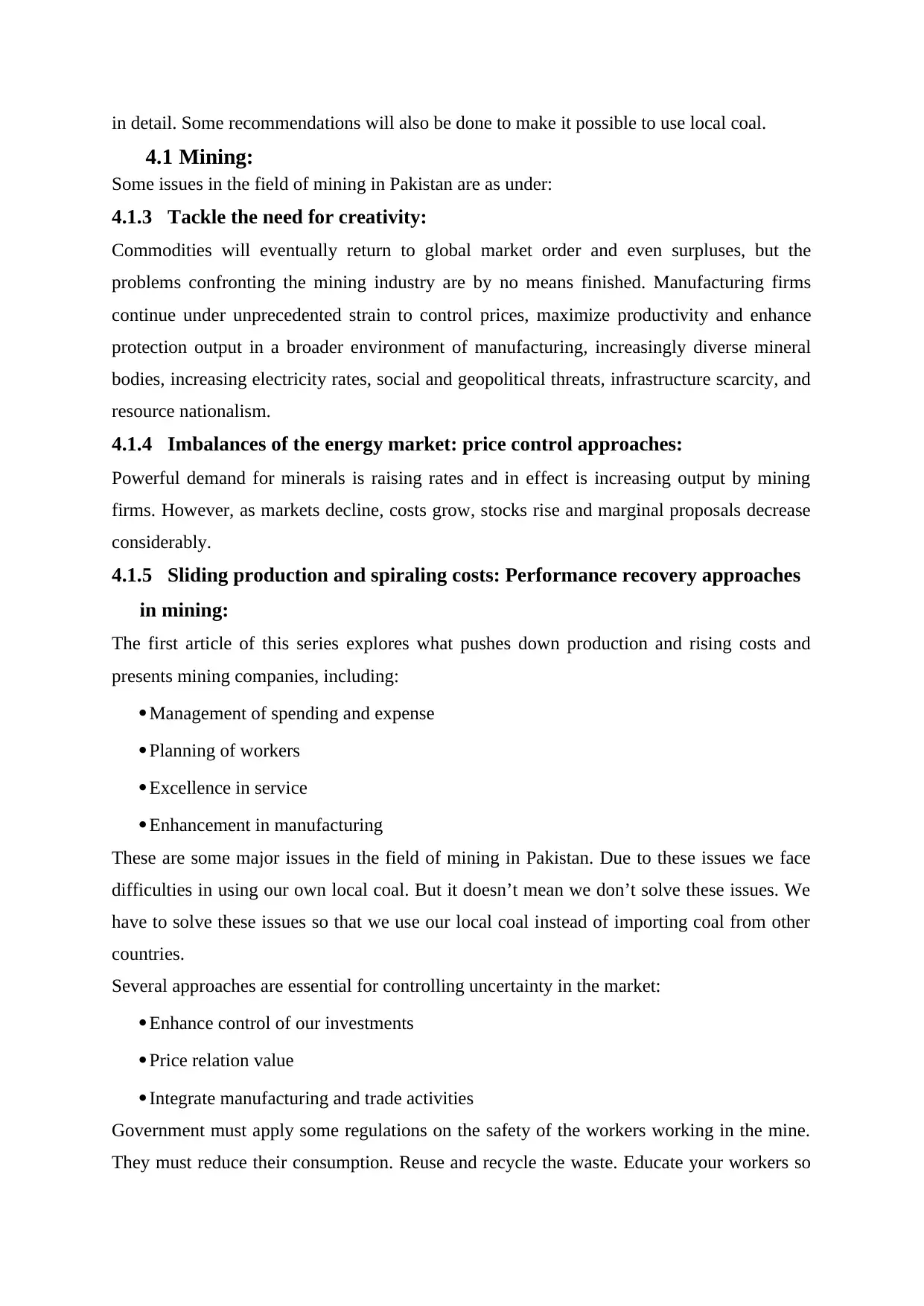
in detail. Some recommendations will also be done to make it possible to use local coal.
4.1 Mining:
Some issues in the field of mining in Pakistan are as under:
4.1.3 Tackle the need for creativity:
Commodities will eventually return to global market order and even surpluses, but the
problems confronting the mining industry are by no means finished. Manufacturing firms
continue under unprecedented strain to control prices, maximize productivity and enhance
protection output in a broader environment of manufacturing, increasingly diverse mineral
bodies, increasing electricity rates, social and geopolitical threats, infrastructure scarcity, and
resource nationalism.
4.1.4 Imbalances of the energy market: price control approaches:
Powerful demand for minerals is raising rates and in effect is increasing output by mining
firms. However, as markets decline, costs grow, stocks rise and marginal proposals decrease
considerably.
4.1.5 Sliding production and spiraling costs: Performance recovery approaches
in mining:
The first article of this series explores what pushes down production and rising costs and
presents mining companies, including:
Management of spending and expense
Planning of workers
Excellence in service
Enhancement in manufacturing
These are some major issues in the field of mining in Pakistan. Due to these issues we face
difficulties in using our own local coal. But it doesn’t mean we don’t solve these issues. We
have to solve these issues so that we use our local coal instead of importing coal from other
countries.
Several approaches are essential for controlling uncertainty in the market:
Enhance control of our investments
Price relation value
Integrate manufacturing and trade activities
Government must apply some regulations on the safety of the workers working in the mine.
They must reduce their consumption. Reuse and recycle the waste. Educate your workers so
4.1 Mining:
Some issues in the field of mining in Pakistan are as under:
4.1.3 Tackle the need for creativity:
Commodities will eventually return to global market order and even surpluses, but the
problems confronting the mining industry are by no means finished. Manufacturing firms
continue under unprecedented strain to control prices, maximize productivity and enhance
protection output in a broader environment of manufacturing, increasingly diverse mineral
bodies, increasing electricity rates, social and geopolitical threats, infrastructure scarcity, and
resource nationalism.
4.1.4 Imbalances of the energy market: price control approaches:
Powerful demand for minerals is raising rates and in effect is increasing output by mining
firms. However, as markets decline, costs grow, stocks rise and marginal proposals decrease
considerably.
4.1.5 Sliding production and spiraling costs: Performance recovery approaches
in mining:
The first article of this series explores what pushes down production and rising costs and
presents mining companies, including:
Management of spending and expense
Planning of workers
Excellence in service
Enhancement in manufacturing
These are some major issues in the field of mining in Pakistan. Due to these issues we face
difficulties in using our own local coal. But it doesn’t mean we don’t solve these issues. We
have to solve these issues so that we use our local coal instead of importing coal from other
countries.
Several approaches are essential for controlling uncertainty in the market:
Enhance control of our investments
Price relation value
Integrate manufacturing and trade activities
Government must apply some regulations on the safety of the workers working in the mine.
They must reduce their consumption. Reuse and recycle the waste. Educate your workers so
Paraphrase This Document
Need a fresh take? Get an instant paraphrase of this document with our AI Paraphraser
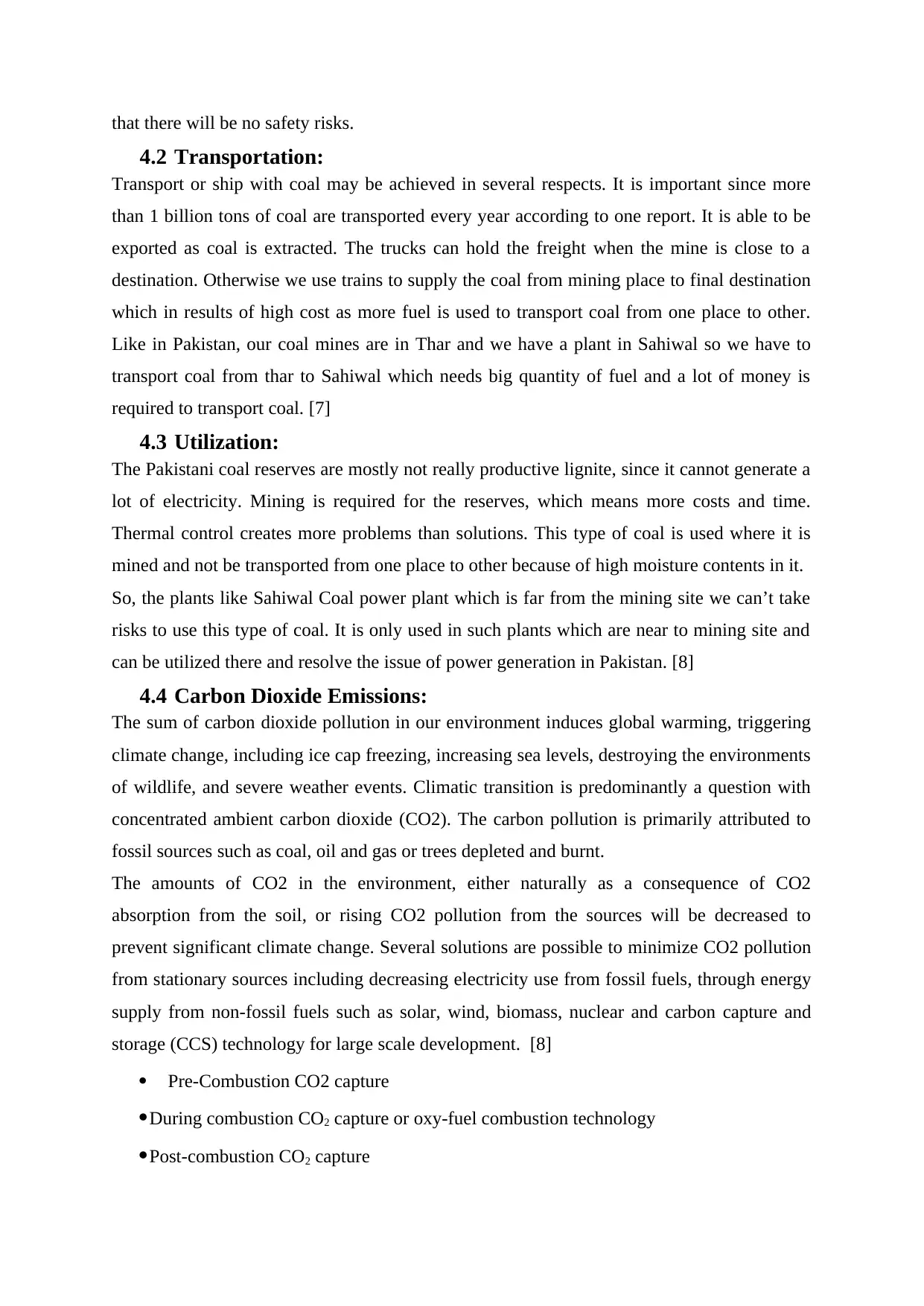
that there will be no safety risks.
4.2 Transportation:
Transport or ship with coal may be achieved in several respects. It is important since more
than 1 billion tons of coal are transported every year according to one report. It is able to be
exported as coal is extracted. The trucks can hold the freight when the mine is close to a
destination. Otherwise we use trains to supply the coal from mining place to final destination
which in results of high cost as more fuel is used to transport coal from one place to other.
Like in Pakistan, our coal mines are in Thar and we have a plant in Sahiwal so we have to
transport coal from thar to Sahiwal which needs big quantity of fuel and a lot of money is
required to transport coal. [7]
4.3 Utilization:
The Pakistani coal reserves are mostly not really productive lignite, since it cannot generate a
lot of electricity. Mining is required for the reserves, which means more costs and time.
Thermal control creates more problems than solutions. This type of coal is used where it is
mined and not be transported from one place to other because of high moisture contents in it.
So, the plants like Sahiwal Coal power plant which is far from the mining site we can’t take
risks to use this type of coal. It is only used in such plants which are near to mining site and
can be utilized there and resolve the issue of power generation in Pakistan. [8]
4.4 Carbon Dioxide Emissions:
The sum of carbon dioxide pollution in our environment induces global warming, triggering
climate change, including ice cap freezing, increasing sea levels, destroying the environments
of wildlife, and severe weather events. Climatic transition is predominantly a question with
concentrated ambient carbon dioxide (CO2). The carbon pollution is primarily attributed to
fossil sources such as coal, oil and gas or trees depleted and burnt.
The amounts of CO2 in the environment, either naturally as a consequence of CO2
absorption from the soil, or rising CO2 pollution from the sources will be decreased to
prevent significant climate change. Several solutions are possible to minimize CO2 pollution
from stationary sources including decreasing electricity use from fossil fuels, through energy
supply from non-fossil fuels such as solar, wind, biomass, nuclear and carbon capture and
storage (CCS) technology for large scale development. [8]
Pre-Combustion CO2 capture
During combustion CO2 capture or oxy-fuel combustion technology
Post-combustion CO2 capture
4.2 Transportation:
Transport or ship with coal may be achieved in several respects. It is important since more
than 1 billion tons of coal are transported every year according to one report. It is able to be
exported as coal is extracted. The trucks can hold the freight when the mine is close to a
destination. Otherwise we use trains to supply the coal from mining place to final destination
which in results of high cost as more fuel is used to transport coal from one place to other.
Like in Pakistan, our coal mines are in Thar and we have a plant in Sahiwal so we have to
transport coal from thar to Sahiwal which needs big quantity of fuel and a lot of money is
required to transport coal. [7]
4.3 Utilization:
The Pakistani coal reserves are mostly not really productive lignite, since it cannot generate a
lot of electricity. Mining is required for the reserves, which means more costs and time.
Thermal control creates more problems than solutions. This type of coal is used where it is
mined and not be transported from one place to other because of high moisture contents in it.
So, the plants like Sahiwal Coal power plant which is far from the mining site we can’t take
risks to use this type of coal. It is only used in such plants which are near to mining site and
can be utilized there and resolve the issue of power generation in Pakistan. [8]
4.4 Carbon Dioxide Emissions:
The sum of carbon dioxide pollution in our environment induces global warming, triggering
climate change, including ice cap freezing, increasing sea levels, destroying the environments
of wildlife, and severe weather events. Climatic transition is predominantly a question with
concentrated ambient carbon dioxide (CO2). The carbon pollution is primarily attributed to
fossil sources such as coal, oil and gas or trees depleted and burnt.
The amounts of CO2 in the environment, either naturally as a consequence of CO2
absorption from the soil, or rising CO2 pollution from the sources will be decreased to
prevent significant climate change. Several solutions are possible to minimize CO2 pollution
from stationary sources including decreasing electricity use from fossil fuels, through energy
supply from non-fossil fuels such as solar, wind, biomass, nuclear and carbon capture and
storage (CCS) technology for large scale development. [8]
Pre-Combustion CO2 capture
During combustion CO2 capture or oxy-fuel combustion technology
Post-combustion CO2 capture
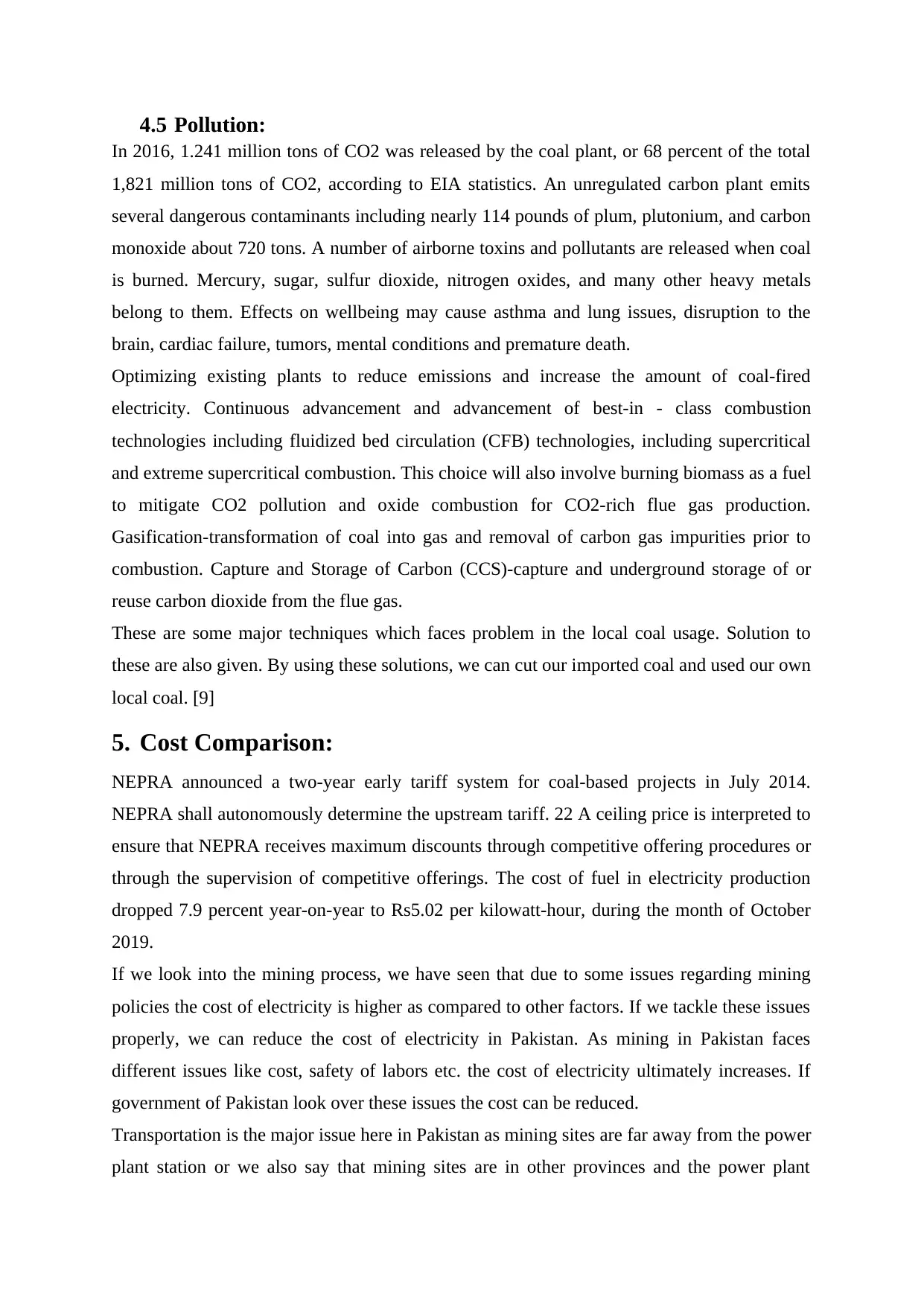
4.5 Pollution:
In 2016, 1.241 million tons of CO2 was released by the coal plant, or 68 percent of the total
1,821 million tons of CO2, according to EIA statistics. An unregulated carbon plant emits
several dangerous contaminants including nearly 114 pounds of plum, plutonium, and carbon
monoxide about 720 tons. A number of airborne toxins and pollutants are released when coal
is burned. Mercury, sugar, sulfur dioxide, nitrogen oxides, and many other heavy metals
belong to them. Effects on wellbeing may cause asthma and lung issues, disruption to the
brain, cardiac failure, tumors, mental conditions and premature death.
Optimizing existing plants to reduce emissions and increase the amount of coal-fired
electricity. Continuous advancement and advancement of best-in - class combustion
technologies including fluidized bed circulation (CFB) technologies, including supercritical
and extreme supercritical combustion. This choice will also involve burning biomass as a fuel
to mitigate CO2 pollution and oxide combustion for CO2-rich flue gas production.
Gasification-transformation of coal into gas and removal of carbon gas impurities prior to
combustion. Capture and Storage of Carbon (CCS)-capture and underground storage of or
reuse carbon dioxide from the flue gas.
These are some major techniques which faces problem in the local coal usage. Solution to
these are also given. By using these solutions, we can cut our imported coal and used our own
local coal. [9]
5. Cost Comparison:
NEPRA announced a two-year early tariff system for coal-based projects in July 2014.
NEPRA shall autonomously determine the upstream tariff. 22 A ceiling price is interpreted to
ensure that NEPRA receives maximum discounts through competitive offering procedures or
through the supervision of competitive offerings. The cost of fuel in electricity production
dropped 7.9 percent year-on-year to Rs5.02 per kilowatt-hour, during the month of October
2019.
If we look into the mining process, we have seen that due to some issues regarding mining
policies the cost of electricity is higher as compared to other factors. If we tackle these issues
properly, we can reduce the cost of electricity in Pakistan. As mining in Pakistan faces
different issues like cost, safety of labors etc. the cost of electricity ultimately increases. If
government of Pakistan look over these issues the cost can be reduced.
Transportation is the major issue here in Pakistan as mining sites are far away from the power
plant station or we also say that mining sites are in other provinces and the power plant
In 2016, 1.241 million tons of CO2 was released by the coal plant, or 68 percent of the total
1,821 million tons of CO2, according to EIA statistics. An unregulated carbon plant emits
several dangerous contaminants including nearly 114 pounds of plum, plutonium, and carbon
monoxide about 720 tons. A number of airborne toxins and pollutants are released when coal
is burned. Mercury, sugar, sulfur dioxide, nitrogen oxides, and many other heavy metals
belong to them. Effects on wellbeing may cause asthma and lung issues, disruption to the
brain, cardiac failure, tumors, mental conditions and premature death.
Optimizing existing plants to reduce emissions and increase the amount of coal-fired
electricity. Continuous advancement and advancement of best-in - class combustion
technologies including fluidized bed circulation (CFB) technologies, including supercritical
and extreme supercritical combustion. This choice will also involve burning biomass as a fuel
to mitigate CO2 pollution and oxide combustion for CO2-rich flue gas production.
Gasification-transformation of coal into gas and removal of carbon gas impurities prior to
combustion. Capture and Storage of Carbon (CCS)-capture and underground storage of or
reuse carbon dioxide from the flue gas.
These are some major techniques which faces problem in the local coal usage. Solution to
these are also given. By using these solutions, we can cut our imported coal and used our own
local coal. [9]
5. Cost Comparison:
NEPRA announced a two-year early tariff system for coal-based projects in July 2014.
NEPRA shall autonomously determine the upstream tariff. 22 A ceiling price is interpreted to
ensure that NEPRA receives maximum discounts through competitive offering procedures or
through the supervision of competitive offerings. The cost of fuel in electricity production
dropped 7.9 percent year-on-year to Rs5.02 per kilowatt-hour, during the month of October
2019.
If we look into the mining process, we have seen that due to some issues regarding mining
policies the cost of electricity is higher as compared to other factors. If we tackle these issues
properly, we can reduce the cost of electricity in Pakistan. As mining in Pakistan faces
different issues like cost, safety of labors etc. the cost of electricity ultimately increases. If
government of Pakistan look over these issues the cost can be reduced.
Transportation is the major issue here in Pakistan as mining sites are far away from the power
plant station or we also say that mining sites are in other provinces and the power plant
⊘ This is a preview!⊘
Do you want full access?
Subscribe today to unlock all pages.

Trusted by 1+ million students worldwide
1 out of 17
Your All-in-One AI-Powered Toolkit for Academic Success.
+13062052269
info@desklib.com
Available 24*7 on WhatsApp / Email
![[object Object]](/_next/static/media/star-bottom.7253800d.svg)
Unlock your academic potential
Copyright © 2020–2025 A2Z Services. All Rights Reserved. Developed and managed by ZUCOL.


